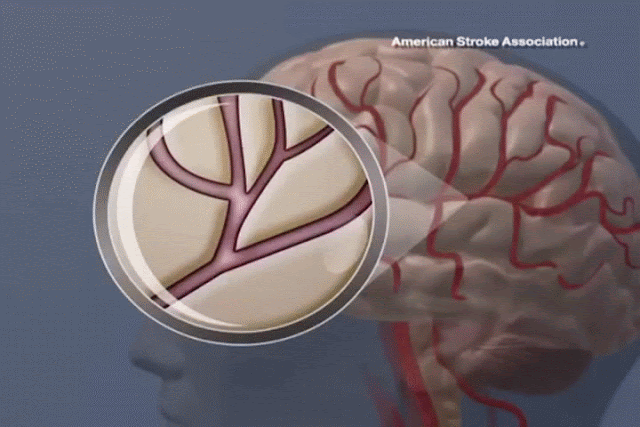A stroke occurs when the blood’s flow to the brain is blocked, or a blood vessel in the brain ruptures. Without blood, brain cells start to die, and the functions controlled by that area of the brain—such as speech or muscle movement—are impaired or lost, the National Stroke Association says.The effects can cause permanent brain damage and disability, depending on how severe the stroke was and how quickly the patient is able to get help.
Other symptoms of stroke include:

- paralysis on one side of the face or body
- sudden blurring or loss of vision, especially in one eye
- difficulty talking
- difficulty swallowing
- nausea
- loss of bowel or bladder control
- appearing “drunk” with unexplained falls or loss of balance
- sudden headache
- confusion
- loss of consciousness
- dizziness
EMERGENCY MANAGEMENT
- If you’re caring for someone else having a stroke, make sure they’re in a safe, comfortable position. Preferably, this should be lying on one side with their head slightly raised and supported in case they vomit.
- Talk to the person. Ask them their name and other questions. If the individual is unable to speak, ask them to squeeze your hand in response to questions. If the person does not respond, they are likely unconscious.
- Check to see if they’re breathing. If they’re not breathing, perform CPR. If they’re having difficulty breathing, loosen any constrictive clothing, such as a tie or scarf.
- Loosen any tight clothing, such as buttoned-up shirt collars or scarves
- If they are cold, use a blanket or coat to keep them warm..
- Check that their airway is clear. If there are objects or substances, such as vomit, in the mouth that may be hindering breathing, place the person on their side in the recovery position (see below).
- Don’t give them anything to eat or drink.
- If the person is showing any weakness in a limb, avoid moving them.
If the person is unconscious:
If someone is unconscious, or if their airway is not completely clear, place them in the recovery position. To do this:
- Kneel beside them.
- Take the arm that is farthest away and place it at a right angle to their body.
- Place the other arm across their chest.
- The leg that is farthest away should remain straight. Bend their other knee.
- Support their head and neck and roll the person onto their side, so that their bottom leg is straight and their top leg is bent at the knee, with that knee touching the ground.
- Tilt their head slightly forward and down so that vomit in the airway can drain out.
- Manually clear out the person’s mouth, if necessary.
- Monitor their airway and breathing. To do this:
- lift the person’s chin and tilt their head slightly backward
- look to see if their chest is moving
- listen for breathing sounds
- place a cheek over their mouth and try to feel their breath
- If there are no signs of breathing, begin CPR (cardiopulmonary resuscitation).
3 Things Not to Do When Someone Is Having a Stroke
1. Do Not Let that person go to sleep or talk you out of calling 102
2.STOP Smoking
3.Do Not Give them medication, food, or drinks
There are 2 kinds of strokes:
- Hemorrhagic stroke, caused by a ruptured blood vessel
- Ischemic stroke, caused by a clot in a blood vessel
“80% of strokes are ischemic ones, but if you’re in that 20% and your stroke was caused by a ruptured blood vessel in the head, you don’t want the victim to have aspirin,” .“And you can’t tell which one it is until you get to the emergency room and you get a CAT scan.” To be safe, don’t give someone who has a stroke any medication. You also shouldn’t give him food or drinks before the ambulance comes. “Sometimes, a stroke affects their ability to swallow,” Jean says.
THINGS TO DO DURING STROKE
- Do talk to the person experiencing a stroke- As you wait for the ambulance to arrive, gather as much information from the person as possible while they’re still able to communicate. Ask about any medications they’re taking, health conditions they have, and known allergies. Write this information down so you can share it with the doctor, in case your loved one is unable to communicate later on.
- Keep the stroke victim in well ventilated room
- Do encourage the person to lie down - If the person is sitting or standing up, encourage them to lie down on their side with their head elevated. This position promotes blood flow to the brain. However, do not move the person if they’ve fallen. To keep them comfortable, loosen restrictive clothing.
If you enjoyed this article, subscribe it!
Stay Fit!
MOVEMENT FOR HEALTH



Comments
Post a Comment